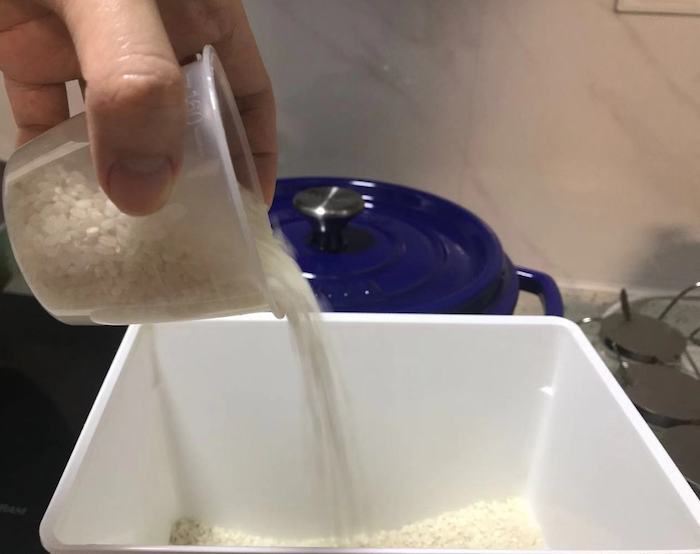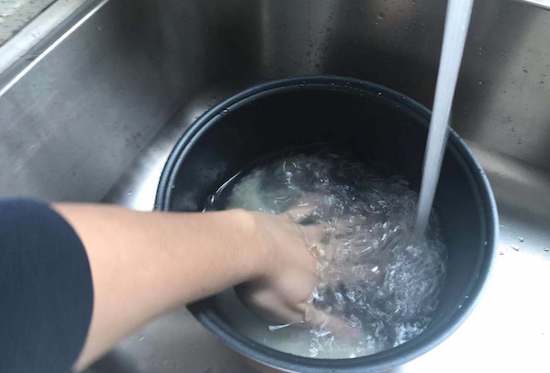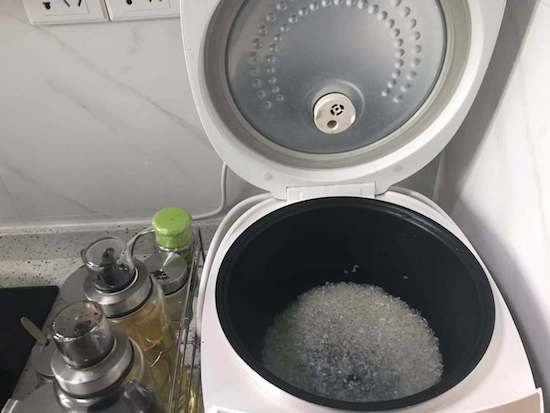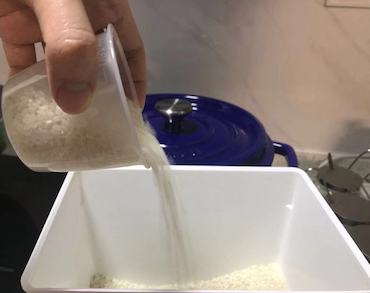We are reader supported. When you purchase through links on our site, we may earn an affiliate commission. Also, as an Amazon affiliate, we earn from qualifying purchases.

I know many people love eating sushi at restaurants but find the idea of making them at home intimidating. Most common fears are associated with how to make perfect sushi rice, how much sushi rice to use per serving, how to put everything together in proportion etc. Trust me, it’s much easier than you think!
(To find out the step-by-step recipes, tips, and tricks on how to make perfect sushi rice in a cooker or pot, read this article.)
Let’s get to how much sushi rice should you make? I estimate one cup of uncooked rice to yield about two cups of cooked and seasoned sushi rice. When making sushi, you will need an only half cup of cooked sushi rice to apply a thin layer on a Nori sheet.
So, one cup of uncooked rice can give you about three sushi rolls. Most people eat about two to three rolls in a sitting, so that means about 1-2 cups of uncooked sushi rice for two people. Here’s a quick breakdown to help you with the measurement:
2 people = 1 to 2 cups
4 people = 2 to 3 cups
6 people = 3 to 4 ½ cups
8 people = 4 to 6 cups
10 people = 5 to 7 ½ cups
I recommend making slightly more sushi rice than your measurement because you may have a few unexpected guests or a guest who may like to eat some more. Running short of sushi rice during a party can be embarrassing and preparing sushi rice all over again can be time-consuming.
Contents
Sushi Quantities Calculator
Or You can use a sushi roll Calculator. Simply select how many rolls you are going to make.
What Type Of Rice Is Best For Sushi?
Many people ask me if they can use different varieties of rice for making sushi, and my answer is a clear No. Other types of rice can change in proportion drastically once cooked, plus they are too dry to be used for making sushi. The beauty of this dish lies in the soft and slightly sticky nature of rice, which cannot be achieved by using different varieties.
The above measurement is strictly for short-grain Japanese rice (click to see
How To Correctly Measure Rice For Making Sushi
Most people commit the mistake of not measuring correctly or using their eyes to estimate/ measure the amount of rice needed for making sushi. While this may work if you are doing a family dinner for 3-4 people, I recommend using a weighing scale to measure properly when you are hosting a party.
If you are using a measuring cup for the rice, make sure you level off the top. Remember that practice makes perfect and the size of your measuring cup may vary the proportion slightly. Just ensure that you make enough rice to accommodate 2-3 extra guests when hosting a sushi party at home.
After you measure out the cups of rice in a bowl, sift through the rice to remove cracked, broken, or immature grains. The rice should be milled properly so that they have a shine on the surface, without any bran residue.
If you are using a rice cooker, remember that any amount of uncooked rice can become twice in the amount once cooked. So, always make sure that the uncooked rice you add to the cooker is 50% less than its overall capacity.
When you need to make sushi rice for ten people or more in a rice cooker, I recommend that you cook in batches instead of trying to make all at once. If you prefer cooking in a pot, then you will need a slightly bigger pot to allow the rice to boil properly.
Cook rice at least 30 minutes to an hour before you are expecting guests to ensure that the rice is well cooked and seasoned before they arrive. To make the perfect rolls, you will need not hot or cold, but slightly warm and freshly prepared sushi rice, preferably at room temperature.
3 Key Things About Making Sushi Rice
After you have measured out the perfect amount of rice for cooking, there are three key things to take care of – rinsing, soaking, and cooking the rice. While I believe that practice makes perfect, if you follow the steps and directions correctly, you may nail it in your very first attempt.
#1. The art of rinsing

Take the measured amount of rice in a sieve bowl with small holes so that rice cannot pass through. Place the bowl under a tap and let cold water run through the rice. Use your hands to gently rub the rice to remove the white powdery coating over the grains. Be careful not to break the grains. Keep rinsing until the water running through the sieve becomes clear.
If you don’t have a sieve bowl, transfer the uncooked rice into a large bowl, fill it with water, and then drain the water. Fill water again and this time rub the grains smoothly to remove any dust and dirt. Repeat this for 2-3 times more until the water no more turns hazy and stays clear when filled inside the bowl.
# 2. Soaking rice

This is the next key step to ensure that the rice looks fluffy and whole, with a sheen on the surface when cooked. For best results, you must let the rice soak in water for at least one hour in summer and about two hours in winter, depending upon the humidity level in the atmosphere.
After the rice is fully soaked, the weight of the rice may increase by 1.25 to 1.30 times than the raw uncooked rice. If you rub the grains strongly using fingers, it should yield into a powdery mixture. If you are in a hurry, soaking rice for 30 minutes will also do.
#3. Cooking rice
Drain the water after soaking is completed and add fresh water to the pot for cooking rice. Remember to add at least 1.2 cups of water for every 1 cup of uncooked rice to get a perfect consistency. Cover the pot and bring to boil. Reduce heat and let simmer for 20 minutes.
When the rice is cooked, uncover the lid and let eth rice cool a bit. Transfer to a larger bowl and add vinegar seasoning to sushi rice. Let the rice cool down before you start making sushi rolls. Ideally, the rice should be at room temperature when making rolls.
Tips To Enjoy A Better Sushi Experience
- If you are trying to make sushi with raw fish for the first time, I recommend that you use linear fish first and then move to richer and fatty versions as they have a stronger flavor
- Soy sauce is only meant for enhancing the flavor, not cloaking it completely. The right way to do it is to dip a little part of the sushi piece in sauce.
- Don’t use a lot of sushi rice or it will overpower the taste of your fillings. Too much rice will also fill you up faster.
- If you are eating sushi at a restaurant, remember that the chef will already add some wasabi sauce to it. So, eat one piece first and then decide if you would like to add some more.
- Moisten your hands with a mix of water and rice vinegar when handling sushi rice to ensure that the grains do not stick to your hands.
- Remember to wipe your knife with a damp towel before cutting the roll to get neat and clean pieces. Use a sawing motion with gentle pressure to make sure you don’t squish the sushi rice.
Related Questions
How much rice should you use for each sushi roll?
You need to make an even layer of sushi rice on the Nori sheet, not too thick and not too sparse. I recommend using a half-cup of sushi rice to apply the oven half sheet of Nori. Make sure you leave out the edges slightly to make rolling easier.
Related Article: Why Is My Sushi Rice Too Sticky?
How much filling should you add to sushi rolls?
Sushi is a delicacy that presents you with assorted flavors that comes from the Nori, sushi rice, fillings, toppings, and sauces. I recommend keeping the fillings to just one or maximum two so that you can enjoy the flavors to the fullest. If you try filling up your roll with all kinds of vegetables that you can find, the individual flavors will be lost.
As a beginner, I would recommend that you start with cucumber sushi, which is easy to make and refreshing. When you get a hang of how to roll perfectly, you can use sushi-grade fish such as tuna, salmon, or mackerel. With more practice, you may combine raw fish with cucumber, avocado, or another vegetable of your choice.
Related Article: 30 Good Ideas for Sushi Roll Fillings
The Final Words
I prefer making sushi for dinner and even hosting sushi parties than ordering them from an expensive restaurant. It not only saves money but also lets me spend more on better quality ingredients. If you prepare rice and fillings beforehand, your guests can also participate in making sushi rolls and build an appetite.
Just make sure you prepare sushi rice 30 minutes to an hour in advance to allow enough time to cool down. Refer to the measurements mentioned above and take a little more than what you think will be enough. The sushi rice should not be too firm or too mushy, just enough to give your roll a nice texture and hold the fillings tightly!



Comments
Pingback: Best Rice Cookers for Sushi 2020 - Unbiased Review - Easy Homemade Sushi
Pingback: 30 Good Ideas for Sushi Roll Fillings - Easy Homemade Sushi